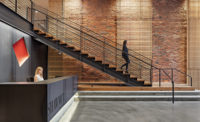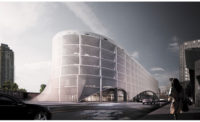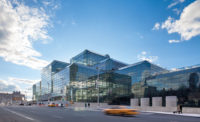Learning and brick-building share a deep affinity: to build with brick is to join a conversation that’s almost as old as civilization itself. Academic structures are often brick, so it’s a common choice for new ones. Yet, despite all that’s been said in brick in the last 9,000 to 10,000 years (including brick’s own preference for an arch, as Louis Kahn famously told us), each new building has the potential to contribute something fresh, perhaps even astonishing.
In awarding a slew of honors last year to the Saw Swee Hock Student Centre at the London School of Economics, for example, jurors for Britain’s Brick Awards declared themselves “blown away” by what the architects, O’Donnell + Tuomey, describe as “familiar materials made strange”—familiar in that each of the project’s 175,000 bricks was individually cast in a wooden mold by hand, giving the building the same dappled and dimpled surfaces that make old brick walls lovable. They were made strange, said the jury, in that the way the project uses the material “creates a whole new language for brickwork.”
Embedded within a complex network of streets in London’s city center, the form of the Saw Swee Hock building, completed in 2014, responds to the rights-to-light easements of its neighbors, which define the buildable envelope, as well as to lines of sight along the narrow streets. The result is a faceted and canted volume that seems sliced from a larger rectilinear mass.
The planes that make up the building’s complex form are built of long and short bricks, including 46 standard shapes and 127 special shapes, in a pattern based on flemish bond. Except where glazing cuts through the brick envelope for major inflections—at the entrance, for example—windows do not interrupt. Instead, the brick envelope maintains the continuity of the building form by passing right over them, about 8 inches in front of the glass, supported by rectangular-section steel posts aligned with mullions. Where that occurs, short bricks in the bond pattern are omitted to create a perforated screen and let in daylight and air. At night, the windows glow like lattice lanterns, their brick-size apertures expressing the building’s handmade scale.
Extensive drawing and physical and digital modeling, as well as the use of the special shapes, achieved a design that required no brick cutting. Designing with the brick module helped speed the work on-site. It also eliminated waste, thereby improving brick’s already strong environmental profile.
Conservatively warrantied at 100 years, with periodic inspection and repair of joints and flashing in the interim, brick is both durable and recyclable. It is made from clay and shale, some of the most abundant materials on earth. Manufacturing is typically located close to sources, and, in the U.S., the average distance from plant to project site is about 175 miles.
Properly detailed and constructed, brick cladding presents a rugged face to the elements. However, the thermal performance of the envelope can be compromised if relieving angles are attached to a building’s primary structure continuously. To mitigate this thermal bridging, intermittent attachment angles can be welded to the back of the relieving angle to create a gap through which insulation can pass. Proprietary two-part and thermally broken relieving angles are now available to achieve the same result.
Although brick’s range of colors, shapes, and sizes is almost limitless, it’s not uncommon for an academic client to require the use of a specific brick. The University of Rochester, for example, has mandated the same brick on some half dozen projects in the last 10 years alone. But that’s not necessarily a problem. “Once that decision is made, we can move on,” says Frano Violich, principal at Kennedy and Violich Architecture (KVA). “Sometimes it’s good to be limited,” he adds. Violich’s firm is designing the university’s Institute for Data Science, now under construction.
For KVA, the real focus of interest is the contrast between brick’s qualities of thick and thin—the dichotomy between historic multi-wythe, load-bearing walls and contemporary single-wythe suspended veneers. The firm has explored this theme in past academic projects such as Gorkin Hall, at the University of Pennsylvania Law School (record, November 2012, page 109) and the recently completed Tozzer Anthropology Building, at Harvard University.
For the University of Rochester commission, KVA found its inspiration in the project’s program. The focus of study for the new institute is big data: looking for patterns in data streams and assembling them to make sense. “We were interested in working with brick in the same way,” says Violich, and so an analogy emerged between bricks and bits of data.
By turning bricks so they are perpendicular to the wall at computer-scripted intervals, and cantilevering them at varying depths, patterns are generated in a field of bricks. The projecting bricks create a play of light and shadow, as well as an impression of depth in the thin brick veneer. Overall, the bricks appear to flow by in a manner evocative of a data stream.
The challenge in translating this concept into reality was figuring out how to prop the cantilevered bricks so they wouldn’t drop out before the mortar set. Although brick ties or anchors are typically embedded in the mortar between courses of brick, they hold the brick veneer as a whole to the substrate once the mortar sets; they don’t secure individual bricks that would tend to tip while the mortar is soft. So the cantilevered bricks needed additional support, either from the back, with some kind of restraint, or from the front, with a temporary scaffolding or falsework.
KVA’s solution is for the masons to lay the initial course of cantilevered bricks and, once those have set, to stand a temporary wood block on the cantilever to support the next protruding brick a few courses up. “It does require an understanding of the craft and tools used to make a brick wall, and the sequence of construction,” says Violich, “especially when you challenge traditional techniques.”
For Pelli Clarke Pelli’s recently completed Lanphier Center for Mathematics and Computer Science, at Choate Rosemary Hall, a prep school in Wallingford, Connecticut, a scrupulous attention to the craft of building began with selecting the brick. The intention was for the building to look modern and yet fit into the campus as if it had always been there, says Victor Agran, a former Pelli Clarke Pelli senior associate, and now a senior associate with Architectural Resources Cambridge.
After seven on-site mock-ups to test different types and various combinations of bricks, the architects selected, in close consultation with the client, a simple white brick. The white, which makes a pleasing counterpoint to the red brick of a Georgian-style building nearby, derives from a clay coat that is baked in with the brick. (The clay coat, unlike a glaze, provides a vapor-permeable surface.) Seen from a distance, the brick appears uniform—crisp and contemporary; a closer vantage point reveals subtle mottling where the buff tones of the base brick show through. “It got us everything we wanted,” says Agran. “It is monochromatic and abstract yet soft, with a lovely material quality.”
The Lanphier brick is an example of the FBX brick type—one of three ASTM classifications that specify manufacturing tolerances. “FB” stands for facing brick, and the “X” indicates extreme or extra control criteria: corners sharp, edges square, dimensions accurate, chippage tiny and rare. The FBS classification designates standard production bricks, while “FBA” indicates unusual architectural or aesthetic criteria that must be specified, such as handmade or non-uniform molded bricks.
Exactitude on the Lanphier Center didn’t stop with the selection of the bricks—it carried through development of the design and construction. “We did not want brick cut into odd sizes where the wall would begin to look messy,” says Agran, “so we were careful to make sure the brick and brick-joint layout worked precisely.”
For ornamentation, the architects emphasized a modern approach, to contrast with older buildings on campus, using titanium zinc to turn key aspects of the weather envelope—downspouts, gutters, and window frames—into expressive moments. Windows, for example, are deeply inset, with prominent frames and raked sills in gray metal. Downspouts are recessed flush with the surface of the brick and double as expansion joints, thereby eliminating the sealant joints that often mar brick veneer envelopes.
Since a skin with such a high a level of abstraction succeeds or fails on the quality of the brickwork, the architects were on-site nearly every day, climbing the scaffolding to monitor progress and quality. Once expectations were clear, the masons began catching imperfections on their own initiative, winnowing 10 masons down to six who could reliably meet the project’s standards, which, of course, made the work slower.
Those masons might want to swap stories with the crew from the Chau Chak Wing Building, designed by Frank Gehry for the business school at the University of Technology Sydney. On a typical project, a mason can lay 400 to 600 bricks a day, according to Gus Galati, supervisor with Favetti Bricklaying, masonry contractors for the project. Here they averaged 70 to 80—on a straighter run, maybe 100 to 120, Galati says. “At the beginning, it was embarrassing.”
Even so, the brickwork was finished ahead of schedule. “It helped that we had the most enthusiastic team of bricklayers I have ever met,” says Brad Winkeljohn, a senior associate at Gehry Partners and project architect for the building, which was finished in late 2014. Much of the team’s enthusiasm arose from pitting their skill against the challenges of walls that were, to understate the case, not straight.
For more than 30 years, Gehry has been drawing inspiration from artwork that creates an impression of movement in stone—the flowing and folding of robes, for example, in the sculptures of Michelangelo, Bregno, and Bernini. But in this project, “he really wanted to push the envelope,” says Winkeljohn. “The sheer mass of the brick swerving in and out over your head—it’s amazing.”
For all the visual complexity of the walls, only three main types of brick were needed in the end: a typical brick, a lipped brick to accommodate support angles, and a “K” brick to create the wall’s roughened nap. Corner versions of the typical and lipped bricks brought the total number to five. All are solid dry-pressed bricks, a variation on molded bricks, which enabled the intricate shapes to be formed.
While panelizing the brickwork could have brought the bricklaying indoors, improving speed and accuracy, Gehry was adamant that the brick be laid on-site. He wanted it to be legible as a handmade process, with the softness and warmth human touch imparts. So, for the design team, facilitating the work of the bricklayers became an important objective.
To free the bricklayers to do what they know best, the project team built the envelope’s formal complexity into the supporting substrate, an egg-crate framework of mild steel fins generated using software and technology imported from the aeronautics and automobile industries. The panelized substrate was pre-assembled, complete with brick tie holders to eliminate the need for decisions on-site as to number and placement of ties.
The ties consist of a threaded rod with a washer that is set into a continuous groove in the top of the brick, and another, smaller, washer that tightens behind the brick to lock it into place. They support the weight of corbelled bricks so that the bricks don’t tilt while the mortar is soft, and so the more dramatically undulating parts of the wall don’t have to defy gravity on the strength of mortar alone.
While few projects are likely to confound convention to the extent Gehry has done with the Chau Chak Wing building, many new directions still remain for the long conversation that is brick. “There’s not a whole lot of people out there pushing its limits,” says Winkeljohn. “It’s a fabulous material, and it’s underused.”
Katharine Logan is an architectural designer and a writer focusing on design, sustainability, and well-being.
|
Continuing Education
 To earn one AIA learning unit (LU), including one hour of health, safety, and welfare (HSW) credit, read “Pushing the [Brick] Envelope,”review the supplemental material listed below, and complete the online test. Upon passing the test, you will receive a certificate of completion, and your credit will be automatically reported to the AIA. Additional information regarding credit reporting and continuing-education requirements can be found online at continuingeducation.bnpmedia.com To earn one AIA learning unit (LU), including one hour of health, safety, and welfare (HSW) credit, read “Pushing the [Brick] Envelope,”review the supplemental material listed below, and complete the online test. Upon passing the test, you will receive a certificate of completion, and your credit will be automatically reported to the AIA. Additional information regarding credit reporting and continuing-education requirements can be found online at continuingeducation.bnpmedia.comSupplemental Material Technical Notes on Brick Construction: Brick Masonry Material Properties Brick Industry Association Technical Notes on Brick Construction: Manufacturing of Brick Brick Industry Association Learning Objectives 1 Discuss some of the qualities that give brick a strong environmental profile. 2 Explain how thermal bridging can be avoided in brick veneer walls. 3 List the different ASTM classes of brick and describe their properties. 4 Describe several methods of achieving sculptural effects with brick veneer walls. AIA/CES Course #K1511A Take the Continuing Education Test |












Post a comment to this article
Report Abusive Comment